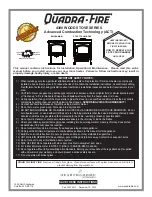
GB
22
prevent overheating. This safety device must not be used as a water heater.
The thermal discharge safety device is not preassembled for safety reasons
during transport and installation, but instead enclosed in the combustion
chamber. During installation, it must be fitted to the marked connection.
Then, use the adapter to screw the capillary line to the TAS. This has been
tested and approved for a minimum throughput of 900 kg / h of water.
The following instructions must always be complied with for the installation,
so that the safety device can function:
• At the cold water inlet, a flow pressure of at least 2 bar must be available.
This pressure must be constantly ensured. This is because, operation on
a mains-voltage-dependent domestic water supply is not permitted!
• Minimum water throughput of approx. 900 L/h must be ensured. It must
not be possible to shut off this supply line!
• It must be ensured that cold water (5-20°C) is available at any time.
Domestic water supplies is not included in this.
All safety-relevant components must be integrated in the system in such a
manner that function and leak-tightness can be checked at any time. The
discharge of the thermal discharge safety device must be designed in such a
manner that a check (e.g. via a drain with siphon) can take place at any time.
Before commissioning, the cold water pipe must be purged! This flushes out
dirt, which would otherwise impact closing of the TAS. The manufacturer's
instructions for the TAS must be observed.
2.3.7.4 THERMAL PUMP CONTROLLER
For optimum control of the circulating pump, a thermostat is integrated in the
lower compartment. This ensures that the circulating pump starts only with
adequate water temperature (> 60°C). The boiler control or similar devices
can be used as a controller if a switch-on temperature of the pump between
60°C and 68°C is guaranteed. The maximum contact load of the thermal
pump control at alternating current 250 V AC is approximately 10 (2.5) A.
The factory setting of the thermostat has been set to about 62°C. When
the switch-on and switch-off temperature of the circulation pump of return
riser is reached, or undershot, the required water temperature in the water
heat exchanger of the Senso M H
2
O / Piko H
2
O is determined. Optionally, if
conditions so require, the temperature can be adjusted by the installation
company. To do this, the housing cover of the pump thermostat, which is
located in the lower compartment of the stove, must be removed. After
removing the cover, the temperature range can be changed by adjusting
the red screw.
Please note:
If water temperatures fall below 60°C, there is an increasing
risk of temperature falling below the dew point level! This can result in the
formation of shining soot. Furthermore, this shortens the cleaning interval.
We do not recommend that the switch-on temperature is set below 60°C,
but also not set at more than 68°C.
2.3.7.5 ELECTRICAL CONNECTION
The entire electrical installation of the individual components of the heating
system must only be executed by an authorised specialised company. All
electrical installations are to be carried out as per the VDE regulations (e.g.
VDE 0105, VDE 0116, VDE 0100, etc.) and the technical connection condi-
tions of the local power company.
On the Senso M H
2
O / Piko H
2
O, only carry out the electrical installation
from thermostats to the pump of the return flow temperature riser („2.3.7.7
Return flow temperature boost“ on page 25) and to domestic power grid
(
see figure
). The temperature-resistant connection line is about 3.0 m long
and already stuck to the thermostat.
The function of the thermostat switch is to be able to test the hot water (e.g.
from kettle) and the thermometer The cladding must be removed to do this.
















































